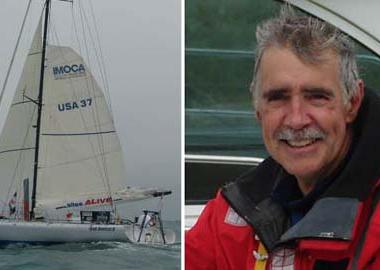 Rich Wilson had followed the Vendée Globe Race ('round-the-world single-handed) since its inception in 1988 but had never considered sailing it himself—“too hard, too long, too dangerous, too risky, too, too, too, the boats were too big, the sails were too big.”
Rich Wilson had followed the Vendée Globe Race ('round-the-world single-handed) since its inception in 1988 but had never considered sailing it himself—“too hard, too long, too dangerous, too risky, too, too, too, the boats were too big, the sails were too big.” Then he reconsidered the possibility when he realized he could incorporate the race into a school program using all the aspects of this global sailing event. As a former Boston Public School teacher, he still felt a strong connection to young students and was certain his ‘sitesALIVE!’ program could get kids excited about the adventure. “They’ll pay attention if they don’t know how it’s going to turn out. The hardest thing about being a teacher is to get kids to pay attention.”
And with that Wilson put together his plan to sail the Vendée Globe in 2008-2009. He lined up newspapers from around the world to carry his story live as he was sailing The Great American III so his students could follow his journey. He put together a team of seventeen experts—maritime affairs, emergency medicine, tanker broker, sleep specialist among them—to complement his daily updates
with their topics of particular interest. Having had asthma from the age of one, he wanted to show his “asthma constituency” how he managed his condition. And finally, he wanted to include seniors. “They weren’t part of the constituency in previous programs, but they are now!” (Wilson was the oldest skipper at the age of 58 when he sailed the Vendée Globe.)
Finally, with all the additional details required by the race itself—insurance, entry fees, previous sailing qualifications, medical approval, offshore emergency medicine training and more—behind him, he was set to start.
While modern technology makes this single-handed race possible, the story that holds your attention is the human one. In the annals of extreme sports—and the physical and emotional demands they make on an individual—sailing 28,000 miles for 17 weeks must surely be at the top. Only fifty skippers have circumnavigated the globe alone.
“Some people call the Vendée Globe the Everest of the Seas, I’m trying to turn that around and say that Mt. Everest is really the Vendée Globe of mountain climbing. Just to get a little respect for the sport.”
In a narrative filled with details of his own moments of vulnerability and drama and those of his running mates, Wilson tells the spellbinding story of medical emergencies and boat dismastings, of those who returned to France and of those who had to drop out. While the Vendée Globe may seem to be a sport about winning—coming in first—it is truly a sport about finishing and the tradition of camaraderie among mariners....Read the full article/Watch Video
Finally, with all the additional details required by the race itself—insurance, entry fees, previous sailing qualifications, medical approval, offshore emergency medicine training and more—behind him, he was set to start.
While modern technology makes this single-handed race possible, the story that holds your attention is the human one. In the annals of extreme sports—and the physical and emotional demands they make on an individual—sailing 28,000 miles for 17 weeks must surely be at the top. Only fifty skippers have circumnavigated the globe alone.
“Some people call the Vendée Globe the Everest of the Seas, I’m trying to turn that around and say that Mt. Everest is really the Vendée Globe of mountain climbing. Just to get a little respect for the sport.”
In a narrative filled with details of his own moments of vulnerability and drama and those of his running mates, Wilson tells the spellbinding story of medical emergencies and boat dismastings, of those who returned to France and of those who had to drop out. While the Vendée Globe may seem to be a sport about winning—coming in first—it is truly a sport about finishing and the tradition of camaraderie among mariners....Read the full article/Watch Video
For more techical information visit our sister website www.engineeringmaintenance.info or for equipment procurement please visit www.engineeringtrader.com

